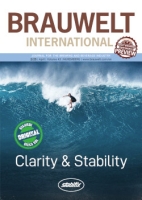Flash pasteurisation (FP) of beer is an important tool for reliable preservation. Combined with a hygienic filler, it is a gentler alternative to tunnel or chamber pasteurisers. The stabilising effect on haze and flavour of FP is becoming increasingly more important. Existing pasteurisation units (PUs) define the dimension of hot holding zones (30 sec) and temperatures (64 - 72 °C). The question arises: are these conventional parameters, using available analytical possibilities and technological objectives, really the optimal solution?
Increasingly, the traditional “beer keg” is being replaced by tank beer delivered by a tank truck. This way, delivering beer is safer, more efficient, much more cost effective and reduces the physical strain often experienced by drivers and catering staff.
Investigations were targeted at determining whether correlations might exist between filterability of beer and the level of α-glucans. It was found that the sum characteristic photometric iodine value correlates neither with filterability according to Raible (Fspec) or Esser (Gmax) nor with pressure increase in the commercial-scale kieselguhr cartridge filter. Filtration problems arising could be attributed to breakdown products of amylopectin and glycogen.
The family-owned brewery de Halve Maan converted an unusual project: it laid a beer pipeline under the old town of the Belgian city Bruges to deliver its beer, brewed in the city center, to its filling plant on a greenfield site. The pipeline was inaugurated on 16th September 2016 and has been fully operational since this day. BRAUWELT International talked to Xavier Vanneste, brewery owner in 6th generation, about the challenges of this adventurous project.
The newly developed GEA clearamic BeerFiltration offers an alternative to current methods of filtration. Unlike filtration with kieselguhr, this option is based on membrane technology. Ceramic membranes not only deliver reliable filtration results, but there is no need to replace the membranes and they pose no hygiene risks. With regard to cleaning, ceramic membranes also exhibit a number of advantages over polymer membranes. In this article, the properties of the ceramic material, the filtration method and procedure are discussed, followed by a review of test results and a calculation of potential cost savings.
Laboratory filtration is a reliable method of predicting filterability of beer. However, this method just gives an indication of the expected filter behaviour. By combining it with prior enzymatic treatment of samples to be tested, it is possible to draw conclusions about filtration-inhibiting substance groups. Results can be of value in helping to improve filterability in the long term.
The American craft beer invasion of Europe is more than competition for markets. It’s as much a battle of beer cultures as it is a battle over the prerogative on taste. BRAUWELT International’s Ina Verstl discusses the repercussions with Belgian beer industry expert Krishan Maudgal.
San Diego, California is situated in the far southwestern corner of the US on the border with Mexico and looks out across the vast expanse of the Pacific. Along with other famous cities further up the coast, like Los Angeles, San Francisco, Portland, Seattle and Vancouver, San Diego is on the extreme western edge of the so-called Occident. Nevertheless, its influence has been felt across the brewing world. The Golden State, as California is known, is the birthplace of American craft beer, and the state’s brewing industry continues to exhibit healthy growth. San Diego was settled by immigrants from Europe, Latin America and Asia, among others, who followed the sun in search of gold. Those still seeking gold in California will find that it still flows in great abundance – as “the juice of the barley”.
This series of articles provides a detailed description of the installation and operation of the thin-layer chamber mash filter (TCM). The design of the mash filter and the results of worldwide inspections were presented in part 1, BRAUWELT International no. 3 2015, pp. 154-158. The following part deals with the question of achieving a full extract yield and discusses the options currently available as well as the limitations.
The following series of articles provides a detailed description of the installation and operation of the thin-layer chamber mash filter (TCM). Part 1 presents the design of the mash filter and the results of worldwide inspections with the aid of tables and images. In Part 2 the author then deals with the question of achieving a full extract yield, demonstrating the options currently available and the limitations.
In the business world there is a cruel joke about Brazil: it’s the country of the future – always has been, always will be. The only thing of which we can be certain is that the future cannot be known, and that any prediction is at best a gamble. Then why did foreign brewers fall for Brazil’s luridly tempting projections?


